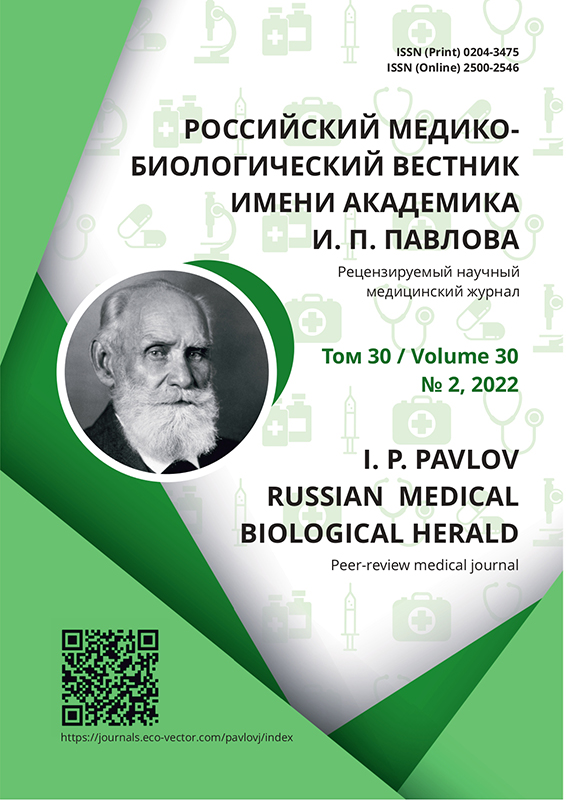Biomarkers of Apoptosis and Cell Proliferation in Diagnosing the Progression of Atherosclerosis in Different Vascular Pools
- Authors: Kalinin R.E.1, Suchkov I.A.1, Кlimentova E.A.2, Egorov A.A.1, Karpov V.V.2
-
Affiliations:
- Ryazan State Medical University
- Regional Clinical Hospital
- Issue: Vol 30, No 2 (2022)
- Pages: 243-252
- Section: Clinical reports
- Submitted: 23.11.2021
- Accepted: 15.02.2022
- Published: 29.06.2022
- URL: https://journals.eco-vector.com/pavlovj/article/view/88938
- DOI: https://doi.org/10.17816/PAVLOVJ88938
- ID: 88938
Cite item
Abstract
INTRODUCTION: The development and progression of atherosclerosis in different vascular pools remain unclear. Many studies have considered apoptosis to play a key role in the development of atherosclerosis; apoptosis is a programmed cell death with characteristic morphological signs aimed at providing homeostasis in an organism in general and in the vascular wall in particular. However, all studies that have been devoted to markers of apoptosis were mostly experimental and were conducted on either animals or grown cultures of different cells. The study aimed to examine markers of apoptosis (р53, sFas, Вах, and Всl-2) and proliferation (platelet-derived growth factor [PDGF] BB) in the vessel wall in the area of an atherosclerotic lesion in a patient with multifocal atherosclerosis. The clinical case was of interest because it allowed the assessment of biomarkers in both the area of progression of atherosclerotic lesion on an operated limb and the carotid pool in the long-term postoperative period.
CONCLUSIONS: This case demonstrated that a patient with obliterating atherosclerosis of the lower limb arteries had an elevated level of pro-apoptotic markers р53 and Вах and PDGF ВВ as a marker of cell proliferation and migration, against the background reduced level of anti-apoptotic markers Всl-2 and sFas in comparison with their values in the normal arterial wall. The progression of atherosclerotic lesion in two vascular pools was associated with a further increase in the values of proapoptotic markers (р53 and Вах) and decrease in the values of Всl-2 and sFas compared with the initial samples. With this, the values of PDGF ВВ marker remained elevated relative to the initial level.
Full Text
About the authors
Roman E. Kalinin
Ryazan State Medical University
Email: kalinin-re@yandex.ru
ORCID iD: 0000-0002-0817-9573
SPIN-code: 5009-2318
MD, Dr. Sci. (Med.), Professor
Russian Federation, RyazanIgor’ A. Suchkov
Ryazan State Medical University
Email: suchkov_med@mail.ru
ORCID iD: 0000-0002-1292-5452
SPIN-code: 6473-8662
MD, Dr. Sci. (Med.), Professor
Russian Federation, RyazanEmma A. Кlimentova
Regional Clinical Hospital
Author for correspondence.
Email: klimentowa.emma@yandex.ru
ORCID iD: 0000-0003-4855-9068
SPIN-code: 5629-9835
MD, Cand. Sci. (Med.)
Russian Federation, RyazanAndrey A. Egorov
Ryazan State Medical University
Email: eaa.73@mail.ru
ORCID iD: 0000-0003-0768-7602
SPIN-code: 2408-4176
MD, Dr. Sci. (Med.), Associate Professor
Russian Federation, RyazanVyacheslav V. Karpov
Regional Clinical Hospital
Email: sdrr.s@yandex.ru
ORCID iD: 0000-0001-5523-112X
SPIN-code: 6245-6292
ResearcherId: ABE-1216-2021.
Russian Federation, Ryazan
References
- Flora GD, Nayak MK. A Brief Review of Cardiovascular Diseases, Associated Risk Factors and Current Treatment Regimes. Current Pharmaceutical Design. 2019;25(38):4063–84. doi: 10.2174/1381612825666190925163827
- Kalinin RE, Suchkov IA, Mzhavanadze ND, et al. Hemostatic changes in patients with peripheral artery disease before and after bypass surgery. Pirogov Russian Journal of Surgery. 2018;(8):46–9. (In Russ). doi: 10.17116/hirurgia2018846
- Grootaert MOJ, Moulis M, Roth L, et al. Vascular smooth muscle cell death, autophagy and senescence in atherosclerosis. Cardiovascular Research. 2018;114(4):622–34. doi: 10.1093/cvr/cvy007
- Pshennikov AS, Deev RV. Morphological illustration of alterations in the arterial endothelium in ischemic and reperfusion injuries. I.P. Pavlov Russian Medical Biological Herald. 2018;26(2):184–94. (In Russ). doi: 10.23888/PAVLOVJ2018262184-194
- Strelnikova EA, Trushkina PYu, Surov IYu, et al. Endothelium in vivo and in vitro. Part 1: histogenesis, structure, cytophysiology and key markers. Science of the young (Eruditio Juvenium). 2019;7(3):450–65. (In Russ). doi: 10.23888/HMJ201973450-465
- Aravani D, Foote K, Figg N, et al. Cytokine regulation of apoptosis-induced apoptosis and apoptosis-induced cell proliferation in vascular smooth muscle cells. Apoptosis. 2020;25(9–10):648–62. doi: 10.1007/s10495-020-01622-4
- Kalinin RE, Suchkov IA, Klimentova EA, et al. Apoptosis in vascular pathology: present and future. I.P. Pavlov Russian Medical Biological Herald. 2020;28(1):79–87. (In Russ). doi: 10.23888/PAVLOVJ202028179-87
- Li W, Dalen H, Eaton JW, et al. Apoptotic death of inflammatory cells in human atheroma. Arteriosclerosis, Thrombosis, and Vascular Biology. 2001;21(7):1124–30. doi: 10.1161/hq0701.092145
- Pérez–Garijo A. When dying is not the end: Apoptotic caspases as drivers of proliferation. Seminars in Cell & Developmental Biology. 2018;82:86–95. doi: 10.1016/j.semcdb.2017.11.036
- Tabas I. Macrophage apoptosis in atherosclerosis: consequences on plaque progression and the role of endoplasmic reticulum stress. Antioxidants & Redox Signaling. 2009;11(9):2333–9. doi: 10.1089/ars.2009.2469
- Li H–Y, Leu Y–L, Wu Y–C, et al. Melatonin Inhibits in Vitro Smooth Muscle Cell Inflammation and Proliferation and Atherosclerosis in Apolipoprotein E-Deficient Mice. Journal of Agricultural and Food Chemistry. 2019;67(7):1889–901. doi: 10.1021/acs.jafc.8b06217
- Kollum M, Kaiser S, Kinscherf R, et al. Apoptosis after stent implantation compared with balloon angioplasty in rabbits. Role of macrophages. Arteriosclerosis, Thrombosis, and Vascular Biology. 1997;17(11):2383–8. doi: 10.1161/01.atv.17.11.2383
- Wan L, Dai SH, Lai SQ, et al. Apoptosis, proliferation, and morphology during vein graft remodeling in rabbits. Genetic and Molecular Research. 2016;15(4). doi: 10.4238/gmr.15048701
- Men H, Cai H, Cheng Q, et al. The regulatory roles of p53 in cardiovascular health and disease. Cellular and Molecular Life Sciences. 2021;78(5):2001–18. doi: 10.1007/s00018-020-03694-6
Supplementary files

















